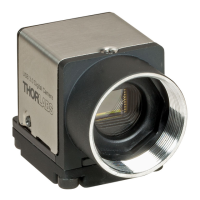© 2016 Thorlabs Scientific Imaging86
DCx Camera Functional Description and SDK Manual
4.1 First Steps to uc480 Programming
This chapter shows the most important functions of the uc480 API for integrating your camera into
your own applications. You will find comprehensive lists of the API functions, sorted by task, in the
How to proceed chapter.
The uc480 SimpleLive and uc480 SimpleAcquire C++ programming samples included in the SDK
illustrate the steps described below.
For information on required include files (uc480 API and header) see Programming notes chapter.
The uc480 API provides different modes you can use to display the camera's images on
the PC. To quickly show a live image under Windows, it is easiest to use the Direct3D
mode. Under Linux the OpenGL mode can be used.
This mode has the advantage that no image memory has to be allocated, and that
image capture is handled by the driver. Call is_SetDisplayMode() to select the display
mode. You can then customize the Direct3D mode by using is_DirectRenderer().
For advanced users:
You can also access the image data directly by selecting the Bitmap (DIB) mode. To use
DIB mode, you first have to allocate one or more memories by using
is_AllocImageMem(), add them to a memory sequence, if required, and then activate a
memory with is_SetImageMem() before each image capture. To show the image on-
screen, call the is_RenderBitmap() function after each completed image capture. From
the events or messages you can see when an image is available for display.
See also:
How to proceed: Display mode selection
Recording live images with the DCxCamera is very simple. Just call the
is_CaptureVideo() function and the camera captures the live images at the default
frame rate. To capture single frames, use the is_FreezeVideo() function. Every DCx
camera of course also provides different trigger modes for image capture. Use
is_SetExternalTrigger() to activate the desired mode before starting the image
capture.
See also:
How to proceed: Image capture
Adjust the frame rate, brightness and colors
To change the frame rate, for example, you call is_SetFrameRate(). With
is_SetColorMode() you set the color mode. Image brightness is adjusted through the
exposure time set with is_Exposure(). You can also implement automatic control of
image brightness and other parameters by using is_SetAutoParameter().
If you are using a color camera, you should activate color correction in order to achieve
rich vibrant colors for on-screen display (is_SetColorCorrection()). To adapt a color
camera to the ambient light conditions, it is essential to carry out white balancing. This is
also done using the is_SetAutoParameter() function.
See also:
How to proceed: Setting camera parameters

